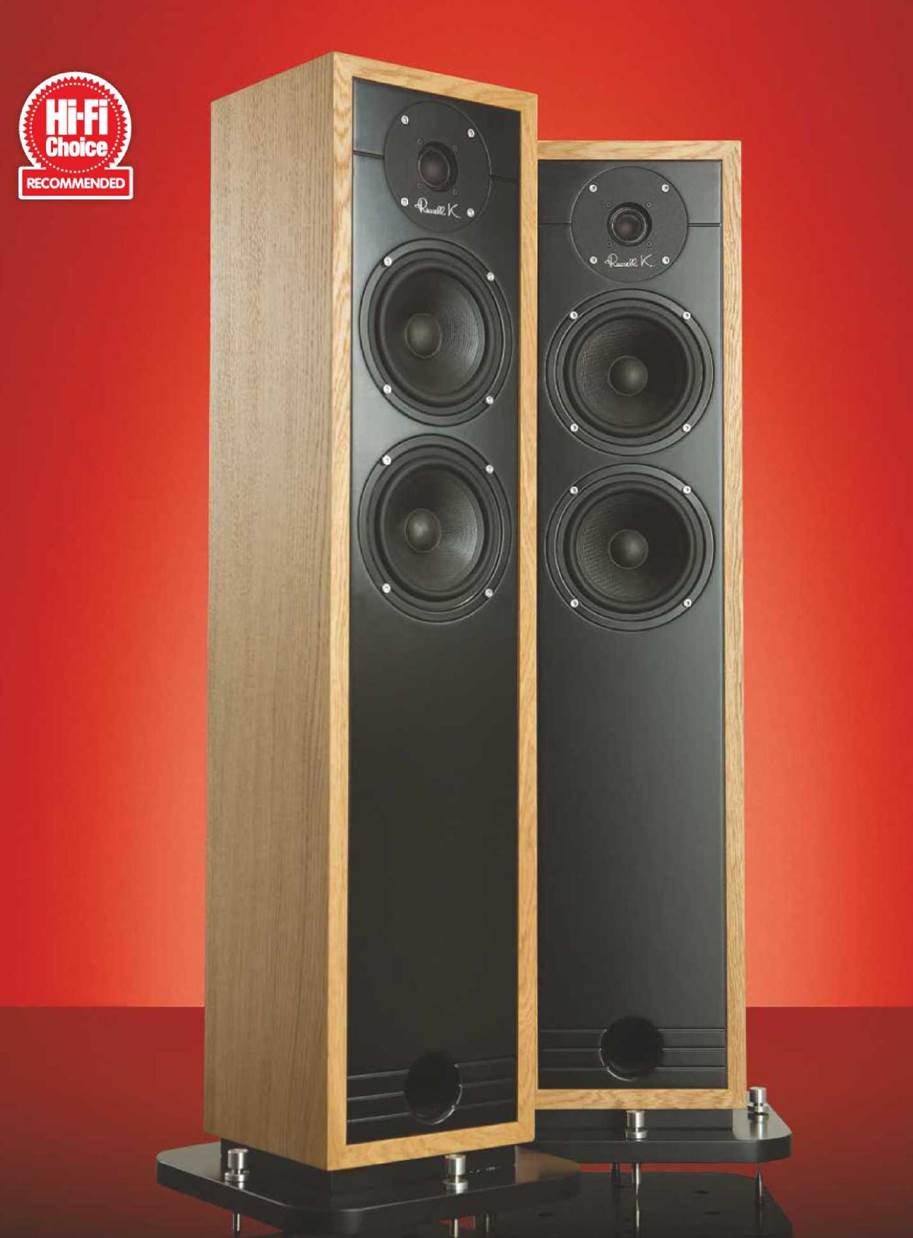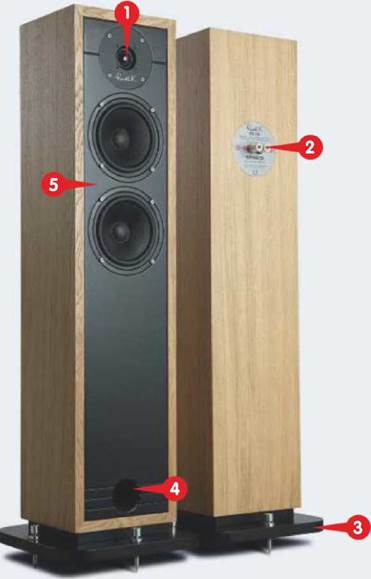Russell K Red 120 Review – Special K
Loudspeakers by Russell Kaufmann may look conventional on the outside, but behind the scenes lies a man with very unconventional beliefs.

When a manufacturer links their products to their own name, it’s always a statement, as it shows they are confident enough in their work to stand behind their devices. Russell Kaufmann developed his ideas and confidence from famous companies like Bowers & Wilkins, Wharfedale, and later the driver manufacturer Morel. He creates designs that are unlike any other. The prices of his loudspeakers have increased significantly due to rising raw material costs, the impact of Brexit, and a new English cabinet maker offering higher quality.
DETAILS
PRODUCT Russell K Red 120
ORIGIN UK/Poland
TYPE 2.5-way floorstanding loudspeaker
WEIGHT 16kg
DIMENSIONS (WxHxD) 200 x 910 x 190mm
FEATURES
• 1x 25mm soft dome tweeter
• 2x 127mm doped paper mid/bass drivers
• Quoted sensitivity: 86dB/1W/1m
DISTRIBUTOR Russell K Ltd.
TELEPHONE 01582 477355
WEBSITE russellk.co.uk
Principles
Every loudspeaker designer aims to reproduce music as faithfully as possible. Russell Kaufmann is no exception: a violin should sound like a violin, and a voice should convey all the emotions of the performance.
However, Kaufmann has developed unique ideas to achieve this, particularly with one design principle: he uses completely undamped cabinets. Does anyone else do this? I can’t think of anyone. There are countless ways to build loudspeakers, each with its own philosophy. The key components are the choice of drivers, cabinet construction, and crossover design. Kaufmann focuses intensely on the cabinet.
Driver Selection à la Russell K.
Unsurprisingly, Kaufmann starts his designs with driver selection. He does something very unusual: he listens to them without a cabinet. I asked him why and how he handles the resulting phase issues and anomalies. He demonstrated it in our video call. First, he placed a well-regarded bass driver next to one from his Red 120 on a table and connected both to a switch box. Normally, he holds them in his hand, turning and adjusting them until all unpleasant artifacts are minimized. Then he played the same piece of music, switching between the two. The difference was striking. One driver sounded broken, the other very good. This method may seem odd, but it works for Kaufmann, and the results speak for themselves.
Quality Materials
Kaufmann found his driver supplier in Poland years ago and has stuck with them. He states clearly that these are not high-end drivers, but simply well-made ones. The woofers feature acoustically optimized, moisture-resistant paper cones, and like the tweeter, they have a classic, powerful ferrite magnet and an aluminum voice coil with a copper ring to minimize Faraday distortions.
The Cabinets
As mentioned, Kaufmann takes a unique approach here, and there’s a story behind it.
While working for B&W, he attended listening sessions hosted by the well-known hi-fi journalist Paul Messenger. Robin Marshall, founder of Epos, also attended. They listened to Messenger’s 15-inch Tannoy coaxial drivers mounted in a wall. Marshall noticed the drivers were damped from behind and suggested removing the damping. Messenger, though skeptical, complied, and the sound improved significantly. Kaufmann believes that energy storage effects in the damping material caused the difference. The improvement was so dramatic that Kaufmann adopted this principle for his designs.
IN SIGHT

1 25mm soft dome tweeter
2 Single-wire binding posts
3 Plinth with levelling system
4 Forward-firing bass port
5 2x 127mm paper mid/bass drivers
The Mix
Kaufmann uses completely undamped cabinets, which he believes only work with thin-walled constructions like those used in BBC monitors, though they use damping. Thick cabinet walls, like damping materials, store energy, releasing it at unwanted times. He uses 19mm MDF for the front due to the driver mounts’ weight, with 16mm for the rest. He then installs three cross braces with varying numbers of holes beneath the drivers for resonance management and to combat standing waves. The number of holes, determined empirically and verified by measurements, affects the acoustic performance, particularly in the bass, where it can sound either muddy or tight and colorful. In the midrange, the differences are minor, but in the treble, they are significant. Kaufmann adjusts the number of holes based on vocal recordings, ensuring the voice sounds right in the room. A fourth brace with an internal opening leads to the bass reflex channel, separating the frequency ranges effectively. He believes that designing the cabinet without damping from the start is crucial for achieving the desired result. The cleverly positioned spikes in the middle of the base allow for easy leveling.
Appropriate Crossover
Kaufmann spent countless hours developing a crossover design that matches his vision of integrated sound.
He settled on a 12dB crossover with only one coil for the woofer and one capacitor for the tweeter. The crossover frequency is a relatively high 2.2 kHz. Kaufmann worked on this crossover for six months, also focusing on its placement in the cabinet. Instead of air-core inductors, he uses ferrite-core inductors, which, despite their quicker saturation, offer very low resistance and minimal stray losses. These inductors are custom-made for his requirements. He has used this crossover design for years, for both the Red 50 and Red 120. The latter is essentially a Red 50 with a subwoofer, sharing identical drivers. The subwoofer, activated by a 6dB iron-core inductor, covers the range from 30 to 80 Hz, enhancing mid and high frequencies by relieving them of bass duties, resulting in a more natural overall sound. Kaufmann also employs a deliberate mismatch in the tweeter’s level and overall phase alignment, a method I’ve previously detailed in LP magazine.
Natural Music
Ernst Reijseger, known for his film scores for Werner Herzog, is one of the world’s most brilliant cellists. His collaboration with pianist Harmen Fraanje and singer-percussionist Mola Sylla resulted in an extraordinary CD, perfect for the Red 120. These speakers handle the music with remarkable transparency and musicality, allowing the listener to focus on the music rather than the speaker. Tracy Chapman’s “Let it Rain” showcases her unique voice and elegant arrangements, with the Red 120 rendering her performance as if she’s singing directly to the listener. Björk’s “Vespertine” challenges the Red 120 with its dynamic and electronic elements, and the speakers impress with their resilience and resolution, avoiding the muddiness that can plague other speakers in this genre. The Red 120s deliver a harmonious and captivating experience, making them ideal for passionate music lovers.

HOW IT COMPARES
Closest in size to the Dynaudio Evoke 30 and Spendor A4 from last month’s Group Test, the Russell K combines their best attributes: the lucidity and lyrical flow of the Dynaudio and the crisp, articulate punctuality of the Spendor while adding an exceptionally fine bass performance all its own. My hunch is it would have given the Group Test-winning KEF R5 a very hard time in sonic terms, even if it can’t quite compete with its sheer value.
Verdict
Unconventional approaches don’t always guarantee success, but Russell Kaufmann’s methods achieve a sound that is natural, modern, and long-lasting. His Red loudspeakers offer a unique listening experience that could be exactly what passionate music enthusiasts have been searching for.
Russell Kauffman
Founder Russell K
Q&A

DV: You have an unusual method of auditioning drive units by holding them in your hand and playing them in open space. How does this work? RK: This method helps me as it eliminates the effects of the cabinet and crossover, enabling me to focus purely on the impact made by the drive units. I want to identify how well or badly a woofer or tweeter resolves detail, and what colouration is in the diaphragm. Loss of detail cannot be retrieved by the crossover or cabinet, so is lost for good. Some designs try to compensate for loss of detail by boosting the treble frequencies in the tweeter. This gives a sense of clarity, but is not natural and over time can cause listener fatigue.
Is the Red 120 just a 50 with deeper bass or does it offer other qualities?
The Red 120 has a significantly more sophisticated cabinet system. The Red 50 has one internal shelf with a number of apertures designed for mechanical tuning of the bass response. The 120 has three internal shelves with apertures where the lower shelf tunes the bass and the middle and top shelves tune the midrange. Having these extra shelves provides many more tuning options. I spent many hours listening to speech and music to tune the Red 120 midrange to achieve a higher level than the Red 50. The internal port is about tuning the system to a very low 25Hz without having to put a bend in what would be a very long port tube. The internal port feeds into a small chamber then into a second short port, this drastically reduces the air velocity so no port chuffing.
Can you explain how the unusual plinth and spikes levelling system came about?
I would love to claim I got a university to look at spike mountings from a scientific point of view and that it took three years of research. The truth is I got fed up trying to get heavy speakers with spikes in the corners to be both level and not rock, while at the same time keeping my hands from being crushed under the weight. It just came into my head one day, and I thought “Why not?”






